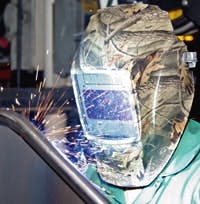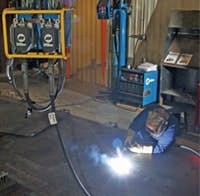12 tips for improving welding safety
Welding safety practices and equipment are universally applicable. Welding exposes everyone to similar hazards, whether you’re responsible for safety at a large, welding-intensive manufacturing company, a billion-dollar engineering-construction firm or a small, independent fabricator. Here are 12 tips for improving welding safety in your company, including advice that also improves productivity.
Read the book. A welder’s operating manual contains important safety information, as well as informational procedures that maximize the machine’s potential. Make sure everyone who operates the machine is familiar with the manual's contents. If the manual becomes lost or damaged, contact the manufacturer for a replacement. Many manufacturers even provide manuals online. Neither this article, nor any other, should be used as a substitute for the manufacturer’s recommendations.
Button up. Any exposed skin is susceptible to the painful and damaging effects of ultraviolet and infrared rays. Further, sparks can catch in open pockets, pant cuffs or down a shirt that isn’t completely buttoned. These sparks can smolder unnoticed while the welder is “under the hood,” causing serious damage. Button shirt collars, cuffs and front pockets to prevent them from catching sparks and be sure to cover all exposed skin. Do not keep matches or butane lighters in your pockets. Avoid wearing cuffed pants because the cuffs also might catch sparks.
The well-dressed welder protects himself from all the potentially harmful effects of arc welding. Proper protection includes: safety glasses, head gear, a welding jacket, an industrial-grade helmet, welding gloves, a leather apron, denim pants without cuffs and leather shoes.
Wear the proper gear. Neither shorts nor short-sleeved shirts belong in a welding cell. Even a quick tack weld requires the proper safety gear, including a helmet, gloves and appropriate clothing.Wear only flame-resistant clothing, such as denim pants and a shirt made from tightly woven material or a welding jacket. The excuse that welding jackets are too heavy, hot, restricting or cumbersome is quickly becoming a thing of the past. Makers of safety gear now produce lightweight clothing from flame-resistant cloth, pigskin leather and combinations of the two that offer better protection and increased ease of movement.
Gloves, too, have progressed beyond the one-size-fits-all type. They are now available with ergonomically curved fingers and with different designs for specific welding processes. Heavy-duty MIG/Stick gloves, medium-duty MIG gloves and TIG gloves that provide added dexterity and touch are just some of the options available. Remember that gloves are not sufficient to pick up just-welded material. Use pliers to avoid burns.
Wear the right shoes. High-top leather shoes or boots provide the best foot protection. Pants legs should go over shoes. Do not wear tennis shoes or cloth shoes that can smolder, causing a burning sensation.
Breathe freely. Fumes and smoke emitted during welding pose a health hazard. When welding in confined spaces, toxic fumes may accumulate, or shielding gases might replace breathable air. Use an exhaust hood to remove fumes from the area and ensure enough clean breathing air is available. Some materials specifically require respirators when welding, so consult the manufacturer's welding electrode data sheet, your welding engineer or an industrial safety specialist for proper procedures.
Don’t see the light. It takes only a moment of exposure to a welding arc’s rays for unprotected eyes to experience “arc flash,” a painful condition that might not appear until hours after the exposure.
Welding helmets should be fitted with a proper filter shade to protect the operator’s face and eyes when welding or watching. Note that approved safety glasses with side shields and ear protection should also be worn under the helmet. Install screens or barriers where appropriate to protect others from the arc.
Pick a lens shade appropriate for your welding application. OSHA offers a guide for choosing the correct lens based on welding criteria. If your weld parameters and materials don’t vary, a fixed-shade lens might be right for you.
Auto-darkening welding helmets enable Vermeer Co. to more easily adhere to production time goals, and reduce operator fatigue. To encourage use, Vermeer splits the cost 50-50 with the operator, and the operator owns the helmet outright after three years.
Use auto-darkening helmets. The sensors on an auto-darkening helmet darken the lens in a fraction of a second. All auto-darkening helmets must meet ANSI standards, the most recent being ANSI Z87.1-2003.Industrial-grade helmets react at speeds of 1/10,000 to 1/20,000 of a second and have adjustable shades settings of #9 to #13 for welding. Industrial-grade helmets also have adjustable sensitivity (useful for low-amperage welding) and delay controls to adjust how long the lens stays dark after the arc stops.
Newer helmets have different modes, allowing the same helmet to be used for welding, cutting and grinding. The most recent development is a mode that senses the arc electromagnetically, offering full protection when the sensors are obstructed, such as when you're pipe welding or welding out of position.
Avoid auto-darkening helmets that darken with a reaction time of 1/2,000 to 1/3,600 of a second. This is not adequate for industrial applications. Further, cold weather delays the reaction time on all auto-darkening helmets. Higher-end helmets are rated for use down to 14°F. However, low-end helmets with slower reaction times might not darken quickly enough in cold weather.
Avoid repetitive stress injuries. When compared to a traditional fixed-shade helmet, an auto-darkening helmet reduces neck fatigue because it is usually lighter and operators no longer need to snap their heads to drop the hood down. Further, an auto-darkening helmet saves several seconds between welds, which quickly adds up to several minutes on larger components. Saving these minutes enables a company to more easily adhere to its build time.
To encourage operators to use an auto-darkening helmet (which costs $300 or more for a professional model), companies like Vermeer Manufacturing Co. (www.vermeer.com) split helmet costs 50-50 with the operator, and the operator owns the helmet outright after three years. To make the helmets easy to purchase, Vermeer’s welding supply partner maintains an on-site inventory.
Lose the clutter. In its welding areas, Vermeer clearly labels and marks the place for each piece of equipment. There is a place for everything, and everything in its place. The weld area should contain only the tools and the equipment that operator uses; nothing more, nothing less. Rather than strictly using a fixed-height table, weld tables have a scissors mechanism that presents the work to the operator at the appropriate height.
Brookville Equipment Corp. equipped its new GoGeneration locomotive line with boom-mounted wire feeders to minimize cable clutter, a potential tripping hazard. The 16-foot boom and 15-foot gun creates a huge work envelope, eliminating the need to lift and move heavy wire feeders.
Use boom-mounted wire feeders. Boom-mounted wire feeders add flexibility, efficiency and operator comfort to high-production welding stations. Booms place the wire feeder controls at the base of a 12- or 16-foot boom and the drive assembly at the end of the boom. The boom rotates 360° and moves 60° up and down to create a 24- or 32-foot diameter work area. A counterbalance holds the boom in place once the operator sets its position.Cameron Miller, safety manager at Brookville Equipment Corp. (www.brookvilleequipment.com), says that, “Boom-mounted feeders are ideal for us. Our goal is to create the safest workplace for our employees, and that includes limiting trip hazards created by cable clutter on the floor and eliminating the lifting of feeders, which might be loaded with up to 120 pounds. of wire. We weld in a variety of positions, from on the floor to up on the locomotives, so we needed a versatile yet clean setup. With boom-mounted feeders, not only can our welders perform their task, but they can maximize safety and productivity at the same time.”
Overall, Brookville’s lost-time incidences are down 90% compared to a year ago, and the boom-mounted feeders play a role.
Optimize fixturing. Use fixturing whenever possible. The simple gearbox rotates a 2,200-pound component. It increases safety by eliminating the use of a chain and hoist to flip the component, which, in turns, eliminates the source of potential hazards.
Stick and carrot approaches. For successful implementation, don’t make welding safety a “program.” Employees tend to suspect programs, and programs tend to fade away after a brief flurry of initial activity. Instead, incorporate safety into daily work habits and use incentives to promote compliance. Brookville uses the carrot approach to safety.
“We make safety a personal goal through rewards. For example, one of our employees is wearing a new Carhartt jacket as result of his safety contributions, and every one of our 165 employees knows the reason why he won that jacket.”
Other corporations use the stick approach. For example, employees who witness a safety violation and do not report it could be subject to the same consequences as the violator. Harsh? Yes, but it conveys a corporation’s safety conviction. Overall, most companies choose to blend stick and carrot approaches as part of their efforts. When welding safety becomes an ingrained part of your corporate culture, you can expect reduced lost-time incidences and improved productivity.
Tom Sommers and Bill Gardner are product managers for Miller Electric Mfg. Co. (www.MillerWelds.com). They respectively manage the development, production and distribution of Miller’s line of auto-darkening and standard welding helmets, and Miller’s line of welding safety apparel.



